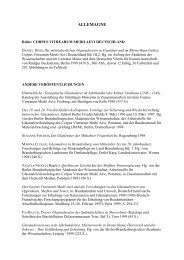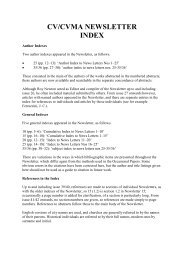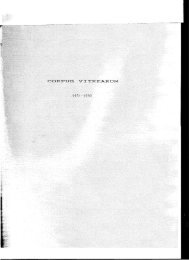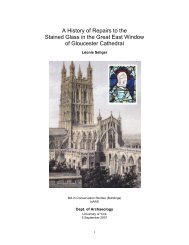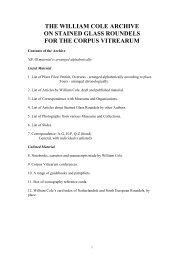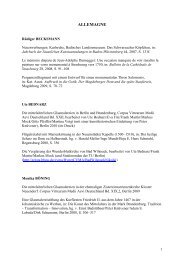BristolConference - Corpus Vitrearum Medii Aevi
BristolConference - Corpus Vitrearum Medii Aevi
BristolConference - Corpus Vitrearum Medii Aevi
You also want an ePaper? Increase the reach of your titles
YUMPU automatically turns print PDFs into web optimized ePapers that Google loves.
itself. Other English cathedrals were rebuilding<br />
their eastern arms at this time (Exeter,<br />
Lichfield), and creating magnificent Lady<br />
Chapels (Ely,Lichfield).<br />
Glazing of the 'New Work', early 1320s to<br />
c.1340<br />
The surviving glass is fragmentary but still the<br />
most complete of its period in England, after<br />
York Minster, roughly contemporary with the<br />
new eastern arm of Saint-Ouen in Rouen. The<br />
glazing of the new parts (el, nII-XI, sII-XI, El,<br />
NII-HI, SII-HI)was carefully planned and may<br />
have been paid for by the Dean and Chapter.<br />
There were band windows in the aisles (nIX-XI,<br />
sIX-XI;main-light panels survive in sII 2d, nHI<br />
2d), with coloured tracery lights. Some of these<br />
are in situ and the figurative subjects were<br />
apparently made in pairs, to fill windows on<br />
either side of the central axis (nIX, sIX).In the<br />
retrochoir, the four chapels were probably<br />
glazed in full colour with standing figures<br />
under canopies and, in the larger windows of<br />
the Lady Chapel, two tiers of these. The<br />
clerestory was in full colour.This contrasts with<br />
the greater use of grisaille at Saint-Ouen,<br />
perhaps in keeping with the ornamental<br />
richness of the English Curvilinear Decorated<br />
style. Throughout, the colours used are ruby,<br />
green, yellow, blue, murrey and a flesh pink.<br />
The glass illustrates the introduction and use of<br />
silver stain, sparingly in the Lady Chapel and<br />
commonly towards the west. Work proceeded<br />
in this direction, following the architecture:<br />
Lady Chapel, built by 1326; north and south<br />
retrochoir chapels, by 1329. Several styles can<br />
be found, but that in the Lady Chapel tracery is<br />
found also in the choir aisles, indicating some<br />
continuity in the workforce.<br />
The Lady Chapel glass was probably conceived<br />
as an entity iconographically. In the east<br />
window (eI), as elsewhere in the chapel, the<br />
canopies are 14 th·c.The figures are an intelligent<br />
restoration by Thomas Willement (1845),<br />
pioneer of the revival of medieval glass<br />
techniques in England. An antiquarian source<br />
records inscriptions naming types of Christ<br />
originally, including Adam, with Eve and the<br />
serpent (part remains of this in 2b), all<br />
prefiguring the Incarnation. In the tracery is the<br />
Second Coming, partly original. This window is<br />
the centrepiece of a composition that still<br />
includes the four Evangelistic symbols at the<br />
top of nII-HI and sII-HI, and busts: nII, nine<br />
patriarchs of the twelve tribes of Israel; sII, the<br />
Church, with prelates including saints with<br />
local connections (Cuthbert, Dunstan). The side<br />
windows are filled with fragments moved from<br />
other windows in the cathedral in the 18 th and<br />
early 19 th centuries.<br />
In the retrochoir chapels, each east window<br />
(nIV, nVI, sIV, sVI) contained a Crucifixion<br />
originally - part survives in the tracery of sVI.<br />
In the ten main lights of the southernmost<br />
chapel, inscriptions (nII 3-4d, sII 1c)reveal that<br />
there were originally Virgin martyrs and the<br />
Magdalene, reflecting the dedication to St<br />
Katherine, Margaret, Mary Magdalene and all<br />
the virgin martyrs, which was also spelt out in<br />
an inscription (now sII 1c-e). The traceries of<br />
nV and sV include prelates beneath Christ.<br />
In the eastern aisle traceries (nIX-XI, sIX-XI)<br />
are figures of St Michael (nIX, sIX), St John<br />
the Baptist (nXI) and a Crucifixion (nX),<br />
representing three of the great quarterly feasts<br />
of the liturgical year. Some tracery panels in the<br />
lower windows have been moved: at the top of<br />
sIV is a Christ from a Coronation of the Virgin;<br />
the Virgin and Child in sXwere once in sVIII.<br />
The five eastern windows of the clerestory are<br />
the best preserved in the cathedral, from a set of<br />
seven in the three new bays of the choir. They<br />
are substantially complete and unrestored<br />
(SII-HIwere conserved by York Glaziers Trust,<br />
1990s). The east window shows the Tree of<br />
Jesse in the main lights, with the Crucifixion at<br />
the top, and the Last Judgement in the tracery<br />
(Christ lost). An inscription at the foot of the<br />
window may be reconstructed: 'Sic Deus ex<br />
Iesse vitam ... adesse', the context implying an<br />
analogy between the Tree of Jesse, Christ's<br />
cross and the Tree of Life. The architectural<br />
surrounds to the main-light figures, both in the<br />
Jesse and the side windows, should be related<br />
to the ornate niches that are a feature of the<br />
architecture and to the development of the<br />
screen reredos in this region. The main lights of<br />
the side windows show standing saints,<br />
martyrs in NII (Blaise, George, Pope) and SII<br />
(Clement, King, Ethelbert of Hereford),<br />
confessors in NHI (Gregory, Giles, Richard of<br />
Chichester) and SHI (Brice,Ambrose, Bishop).<br />
Several styles are detectable and there are<br />
general similarities with other glass in the<br />
region, at Bristol and Tewkesbury, although<br />
none is obviously by the same glaziers.<br />
Documented fund-raising in 1337 and 1338<br />
may be related to a drive to complete the<br />
clerestory,probably by the early 1340s.<br />
Nave and Transepts, late 14th/earlylsth_c<br />
The 13 th _clancets in these parts were remodelled<br />
in the late 14th/early 15 th -c,but the<br />
glass of this period has been very thoroughly<br />
destroyed, the greatest loss in the cathedral.<br />
43



